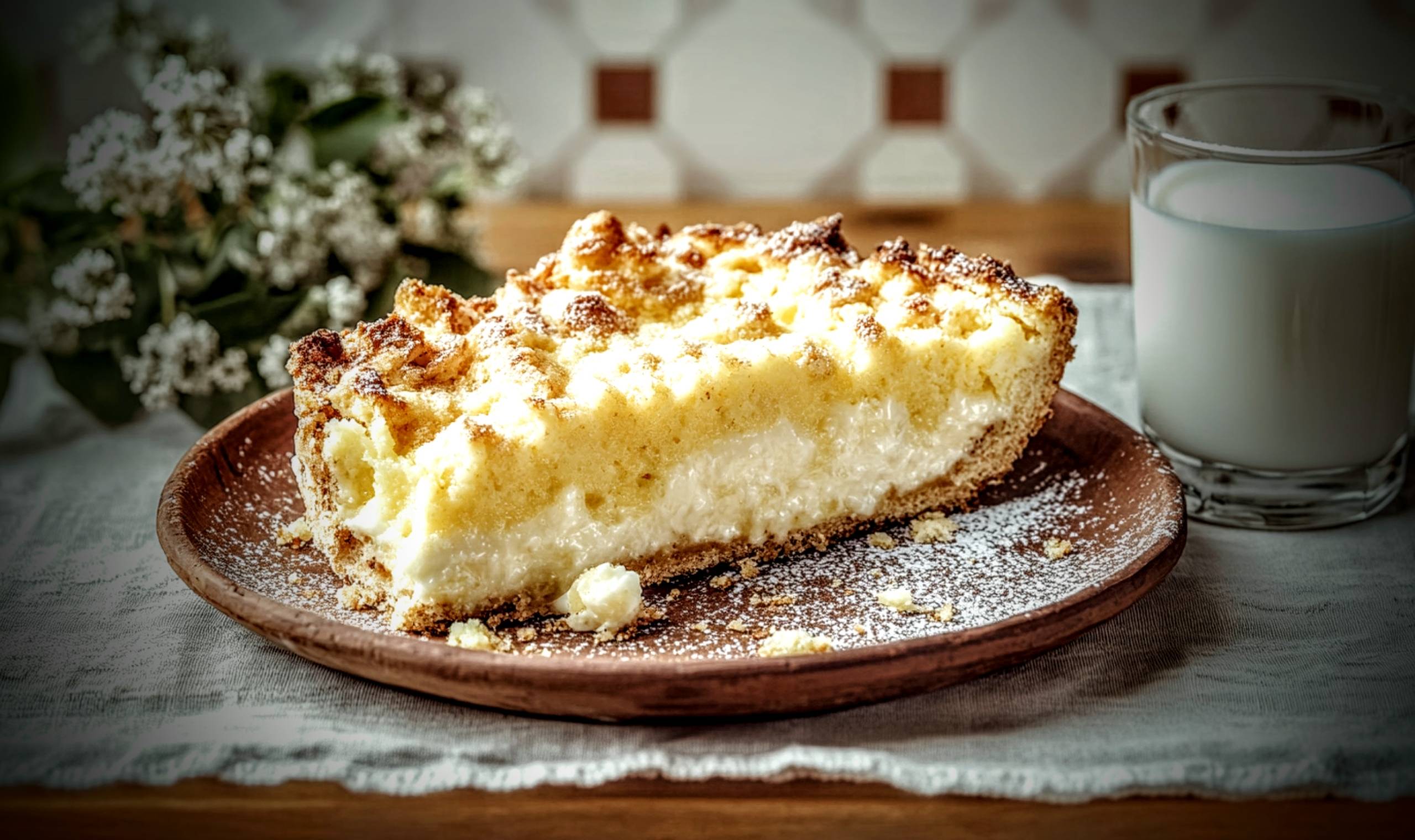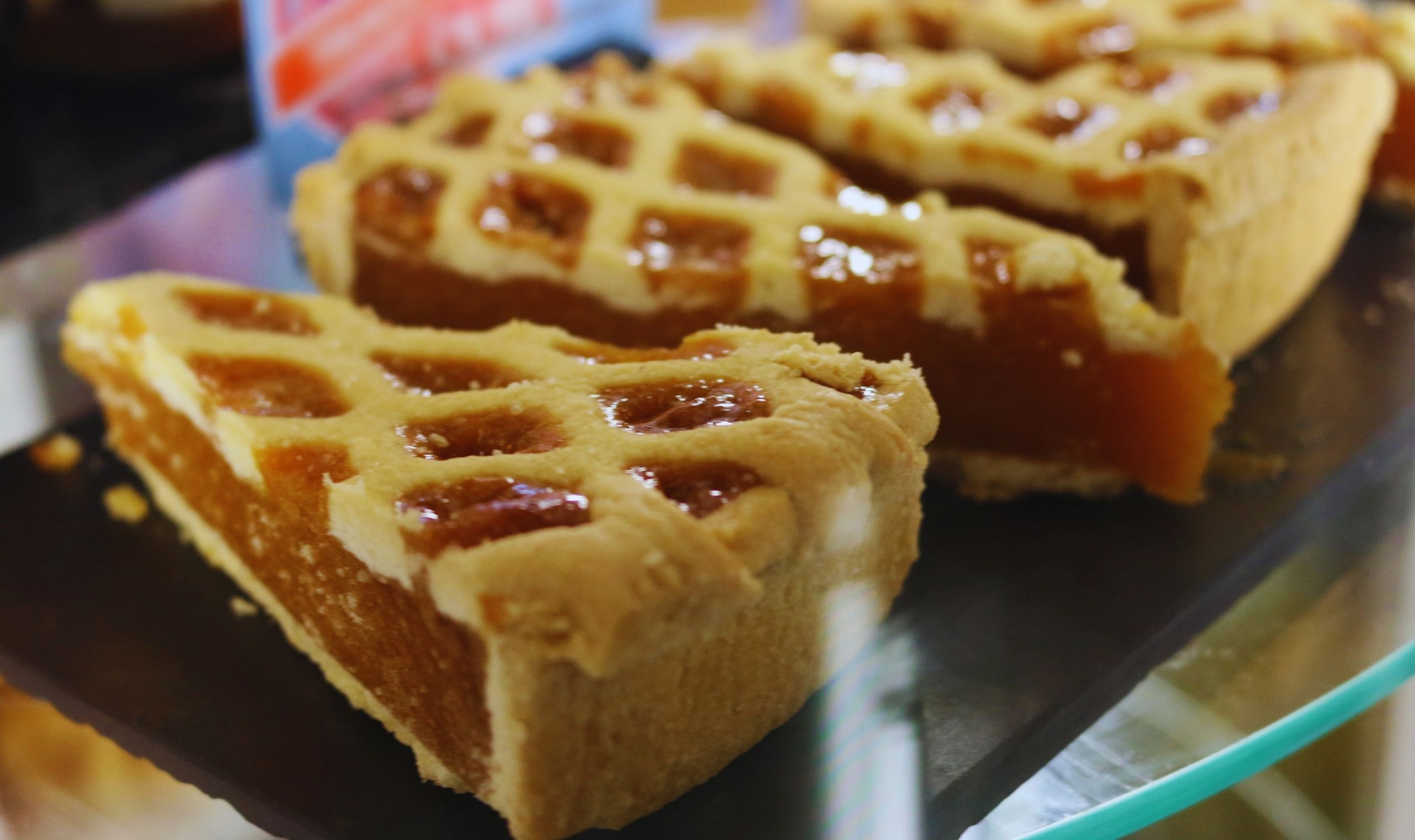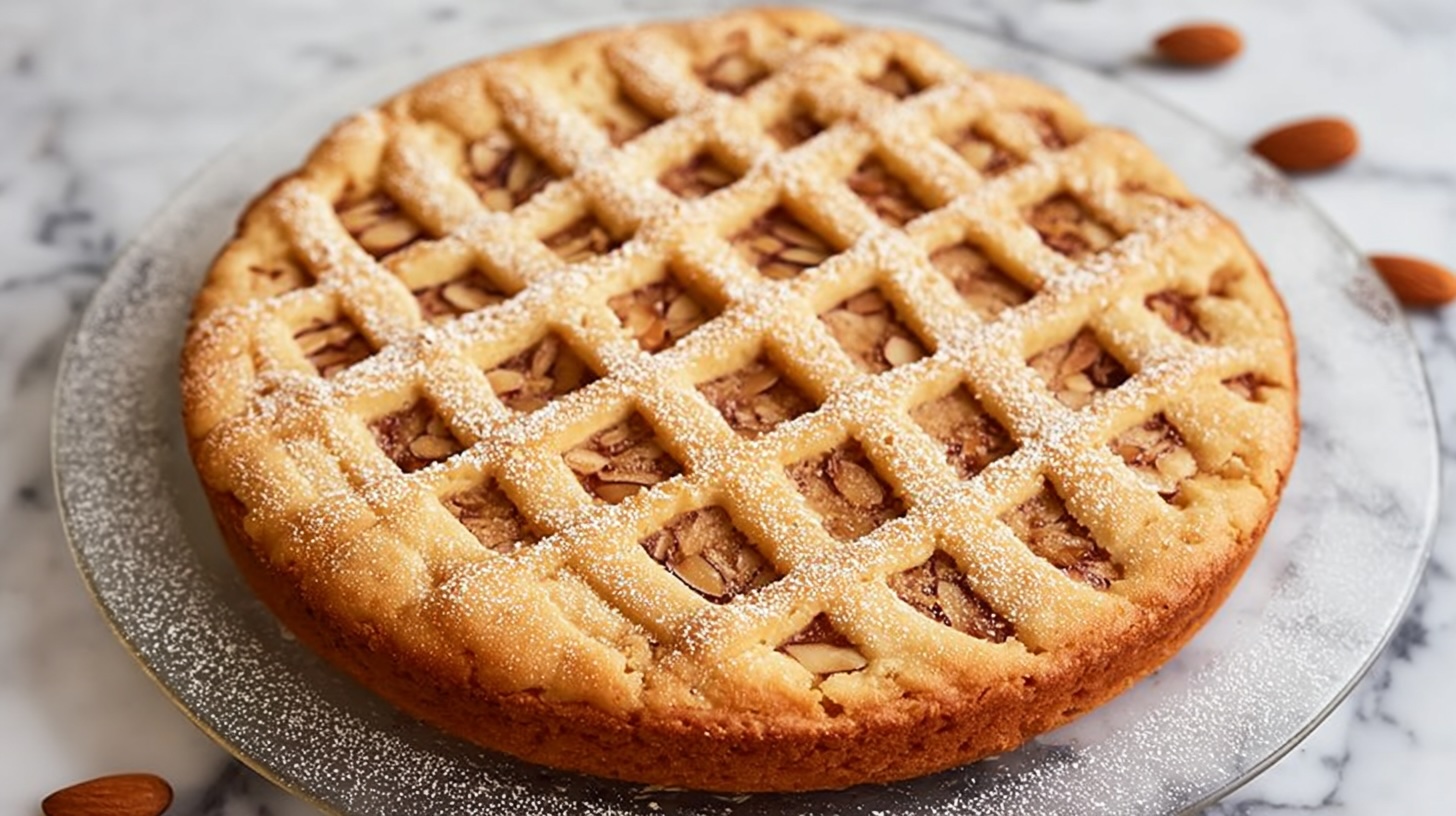Kruimelvlaai: The Dutch Delight of Crumbled Indulgence
What is Kruimelvlaai?
Kruimelvlaai, commonly known as vlaai, is a cherished traditional dessert from the Netherlands, characterized by its unique combination of pastry, fruit filling, and a generous streusel topping. This delightful treat plays a significant role in Dutch culture, often enjoyed during gatherings, celebrations, and as a comforting homemade dessert. The foundation of kruimelvlaai is its rich pastry base, which is both buttery and slightly flaky, providing an ideal counterpart to the sweet fillings and topping.
The filling of kruimelvlaai can vary, with popular choices including fruits such as cherries, apples, plums, and even seasonal berries. Each fruit variety adds its distinct flavor, creating a delectable contrast to the sweetness of the streusel. The fruit filling is typically cooked down to release its juices, resulting in a luscious and moist texture that enhances the overall tasting experience of the dessert. This characteristic is particularly important, as it balances the richness of the pastry and the sweetness of the crumb topping.
The crowning feature of kruimelvlaai is the sweet crumbled topping, a mixture of butter, sugar, and flour that is skillfully blended to create a crumbly and lightly crisp layer. This streusel is not only visually appealing, with its golden-brown color when baked, but also adds a delightful texture that complements the soft fruit filling beneath. The combination of the buttery pastry, fruity filling, and sweet topping makes vlaai an indulgent dessert that is both satisfying and comforting, ensuring its place as a beloved treat among both locals and visitors alike.
The Origins of Kruimelvlaai
Kruimelvlaai, a delightful Dutch pastry, has its roots deeply embedded in the Netherlands, particularly in the Limburg region, where vlaai originated. This traditional pie has a rich historical background that reflects the cultural and agricultural practices of the area. Vlaai, in its various forms, can be traced back to the Middle Ages when it was made by local farmers using ingredients readily available in their surroundings. The art of creating vlaai evolved over the centuries, with bakers experimenting with different fillings and crusts.
The evolution of kruimelvlaai demonstrates the balance between tradition and modernity. Originally, vlaai was made with fruit and yeast-based dough, a hearty reflection of the region’s agricultural bounty. However, as time progressed, bakers began incorporating new ideas into their recipes. The crispy and crumbly topping associated with kruimelvlaai is a relatively modern adaptation that offers a delightful contrast to the soft, fruity filling traditionally found in vlaai. This evolution signifies not just a change in taste preferences but also the adaptability of Dutch culinary traditions.
Culturally, vlaai holds a significant place in Dutch society, especially in Limburg, where it is frequently served at celebrations, gatherings, and festivals. Whether it is a birthday, family reunion, or a local event, kruimelvlaai often takes center stage as a beloved dessert. Its unique combination of flavors and textures not only makes it a delicious choice but also fosters a sense of community and togetherness among those who share it. The continued popularity and adaptation of kruimelvlaai demonstrate its lasting importance as a symbol of Dutch heritage and culinary tradition.
A Slice of History: Vlaai Through the Ages
The origins of vlaai, including the beloved kruimelvlaai, can be traced back to the province of Limburg in the Netherlands. This delectable dessert has roots that date as far back as the Middle Ages, when it is believed that early bakers began experimenting with various types of bread and fillings. Historical records suggest that vlaai was originally prepared to celebrate significant local events, such as weddings and harvests, marking its importance in Dutch culinary traditions.
Over the centuries, the recipe for vlaai underwent numerous modifications, influenced by regional customs and neighboring countries. For instance, the introduction of fruit fillings, such as cherries and apples, came in part from German culinary practices, while the crumble topping that distinguishes cruzmelvlaai had its origins in the desire to create a richer texture that could highlight local grains. The adaptability of vlaai reflects a broader trend in Dutch society, showcasing how culinary traditions evolve through cultural exchange and innovation.
In the 18th and 19th centuries, as more people migrated within the Netherlands and to neighboring regions, the popularity of kruimelvlaai spread, leading to variations unique to different towns and villages. Local ingredients played a prominent role in shaping these variations, with many bakers opting for fresh produce sourced from nearby markets. This connection to local agriculture not only ensured quality but also celebrated seasonal flavors, making vlaai a beloved staple in many Dutch households.
Additionally, vlaai has been a significant symbol of community and tradition, often associated with regional festivities and markets. As the dessert gained recognition, it became a hallmark of Dutch culinary identity, earning its place in cultural heritage. Today, kruimelvlaai continues to thrive, with an enhanced appreciation for its rich history, demonstrating how traditional recipes can evolve while still remaining true to their origins.
Kruimelvlaai Jokes and Fun Facts
Kruimelvlaai, the beloved Dutch dessert, is not only a delight to the palate but also a source of laughter and amusement. One can often find a plethora of jokes and puns associated with this delicious crumbled pie. For instance, why did the kruimelvlaai go to school? Because it wanted to be a little crumby! Such light-hearted jokes demonstrate the playful nature of this dessert, showcasing its presence in Dutch culinary culture in a humorous light.
Beyond jokes, there are some fascinating fun facts surrounding kruimelvlaai that enhance its charm. For example, did you know that the name “vlaai” originates from the Limburg region in the Netherlands? This dessert has roots that date back centuries, and each region boasts its own variations, contributing to an entertaining culinary landscape. A fun aspect of kruimelvlaai is its role in numerous festivals across the Netherlands. Every year, towns host festivals celebrating this crumbly treat, often featuring competitions that test the skill of local bakers. These events not only honor the dessert but also foster community spirit and a shared love for this particular Dutch delicacy.
Additionally, the allure of kruimelvlaai has sparked quirky competitions, from the largest kruimelvlaai to the fastest kruimelvlaai-eating contests. Such competitions invite light-hearted rivalry and showcase the significance of this dessert in Dutch culture. As you delve into the delights of kruimelvlaai, it is noteworthy how it transcends being just food; it has developed into a cultural emblem steeped in history and joy. Engaging with these jokes and fun facts can enhance one’s appreciation for this indulgent treat, allowing us to savor not only its flavor but also its place in Dutch tradition.
Classic Recipes for Homemade Kruimelvlaai
Creating a homemade kruimelvlaai is a delightful experience that combines rich flavors with simple preparations. To begin, you will need to prepare the essential pastry dough. For a classic base, combine 250 grams of all-purpose flour, 125 grams of unsalted butter (at room temperature), 100 grams of granulated sugar, and a pinch of salt. Mix these ingredients until they resemble a fine crumb. Add one egg and continue to combine until a smooth dough forms. Wrap the dough in plastic wrap and refrigerate for 30 minutes. This step is crucial for allowing the butter to firm up, which aids in achieving the desired flakiness.
While the dough chills, you can prepare the filling of your choice, with apple or cherry being traditional favorites. For a cherry filling, about 400 grams of pitted cherries work well. Combine them in a saucepan with 100 grams of sugar and a splash of lemon juice. Gently heat until the cherries release their juices, then thicken the mixture by adding a tablespoon of cornstarch mixed with water. When using apples, opt for tart varieties, such as Granny Smith. Peel, core, and slice about 500 grams of apples, then mingle with 75 grams of brown sugar and a teaspoon of cinnamon for added flavor.
Next, it’s time to create the signature streusel topping that defines a kruimelvlaai. In a mixing bowl, blend together 200 grams of all-purpose flour, 100 grams of sugar, and 125 grams of cold butter until it forms a crumbly texture. To assemble the pie, roll out the chilled dough on a floured surface and fit it into a tart pan. Fill it with your prepared fruit mixture and generously sprinkle the streusel topping over the top. Bake the kruimelvlaai in a preheated oven at 175°C (350°F) for approximately 45 minutes, or until the top is golden brown. Allow it to cool slightly before serving, ensuring that the flavors meld together beautifully. With these steps, anyone can master the art of making a classic kruimelvlaai at home.
Modern Twists on Kruimelvlaai Recipes
Kruimelvlaai, the traditional Dutch crumb pie, has been a beloved treat for generations. However, in today’s culinary landscape, innovative interpretations and variations are becoming increasingly popular. These modern twists on kruimelvlaai maintain the classic essence while incorporating diverse flavors and dietary preferences, appealing to a broader audience.
One exciting approach is to experiment with various fruits to create unique kruimelvlaai flavor profiles. While the classic version usually features juicy cherries or rich apples, contemporary recipes often utilize fruits such as berries, peaches, or even exotic options like mangoes and passion fruit. These fruits not only add a burst of color but also provide a refreshing alternative to traditional fillings, making the dessert suitable for any season.
Another avenue for creativity is the choice of toppings. Beyond the standard buttery crumble, cooks are now exploring options like nut-based toppings, which can add both flavor and texture. Almonds or pecans can complement the fruity filling beautifully, offering a nutty crunch that elevates the classic kruimelvlaai experience. Additionally, drizzling a chocolate or caramel sauce over the pie before serving can further enhance its indulgence, catering to the more adventurous palate.
For those adhering to specific dietary restrictions, vegan kruimelvlaai recipes have emerged, replacing traditional dairy and egg components with plant-based alternatives. Using ingredients such as coconut cream or aquafaba can yield a moist and delicious filling, maintaining the comfort of classic recipes while accommodating vegans or those with lactose intolerance.
These modern twists on kruimelvlaai not only inspire experimentation in the kitchen but also highlight the pastry’s versatility. By integrating various fruits, toppings, and dietary adaptations, home bakers can create a personalized kruimelvlaai that reflects both tradition and innovation.
Where to Buy Kruimelvlaai: The Best Bakeries and Shops
For those who prefer to indulge in the deliciousness of kruimelvlaai without the effort of baking, there are numerous reputable bakeries and shops across the Netherlands where this delectable dessert can be purchased. Renowned for their quality and authenticity, these establishments often serve kruimelvlaai that is crafted from traditional recipes, ensuring a genuine taste experience.
One of the most respected names in Dutch baking is Oliebollenbakkerij van der Wal, famous for its variety of traditional vlaai and other Dutch treats. Located in Limburg, this bakery uses local ingredients to create their kruimelvlaai, capturing the true essence of this dessert. Another prominent option is Bakkerij De Walvis in the province of Gelderland, which is known for its unique toppings and customization options, allowing customers to enjoy innovative twists on this classic dish.
When exploring local shops, it is advisable to seek out those that proudly display their baked goods and emphasize quality ingredients. Look for bakeries that have a strong reputation within their communities or are often recommended by locals. Additionally, specialty food shops may offer artisanal versions of kruimelvlaai made by local bakers, providing a delightful alternative that might incorporate unexpected flavors or seasonal fruits.
To ensure a quality purchase, consider the appearance and aroma of the vlaai. Freshness is vital, and you should look for a vibrant crumble that is neither too dry nor overly soggy. A well-crafted kruimelvlaai should have a rich, buttery aroma, indicative of high-quality butter used in the crumble topping. By exploring these renowned bakeries and local shops, one can easily savor the delicious allure of kruimelvlaai without the need for home baking.
Kruimelvlaai: A Taste of Tradition
Kruimelvlaai holds a special place in Dutch culture, renowned not only for its delightful flavor but also for its significance in various traditions and celebrations. This beloved dessert often graces birthdays, weddings, and holidays, reinforcing its reputation as a symbol of indulgence and community. The unique combination of crumbly topping and rich filling invites appreciation during gatherings, thus establishing a profound connection among those who share it.
In the Netherlands, birthdays are commonly celebrated with treats that reflect the celebrant’s taste, and kruimelvlaai is frequently chosen as a featured dessert. Families gather to enjoy this cake, which encapsulates the essence of hospitality. Its ability to evoke nostalgia makes it not only a sweet finish to the meal but also a tangible representation of love and care from those who prepared it.
Moreover, weddings in the Netherlands often include kruimelvlaai as part of the reception spread, showcasing its versatility. The dessert acts as a conversation starter, allowing guests to bond over shared bites while celebrating the union. In this setting, kruimelvlaai transcends its role as mere dessert; it embodies the spirit of togetherness, inviting laughter, storytelling, and the creation of lasting memories.
Holidays such as Christmas and Easter further highlight the importance of kruimelvlaai in Dutch tradition. It is not uncommon for families to bake or purchase this delightful dish as part of their festive meal, reinforcing the notion that dessert brings everyone together. Sharing a slice of kruimelvlaai represents not only a culinary experience but also a cherished moment of unity among loved ones.
Overall, kruimelvlaai stands as a testament to Dutch traditions, symbolizing the heartfelt connections formed during life’s significant celebrations. The joy it brings when shared accentuates its role in fostering a warm, inviting atmosphere, binding together friends and family through the simple act of enjoying a delicious dessert.
Fun Ways to Serve and Enjoy Kruimelvlaai
Kruimelvlaai, a traditional Dutch dessert, offers a delightful combination of textures and flavors that can be enhanced with a variety of serving options. One simple yet effective way to elevate this crumbled indulgence is to serve it warm, allowing the buttery crumbs to complement a scoop of vanilla ice cream. The contrast of temperatures creates an enticing experience, where the warmth of the kruimelvlaai meets the chill of the ice cream, culminating in a decadent treat that many will find irresistible.
Additionally, pairing kruimelvlaai with a rich dollop of whipped cream can add an extra layer of creaminess to this already delightful dessert. A light dusting of powdered sugar on top provides an appealing finish, transforming the may seem casual into a more polished presentation, suitable for any occasion. Alternatively, incorporating fresh fruit, such as berries or slices of seasonal peaches, can add a refreshing touch that beautifully complements the sweetness of the kruimelvlaai.
For coffee lovers, serving kruimelvlaai alongside a freshly brewed cup of espresso or strong coffee can enhance the overall taste experience. The slight bitterness of the coffee balances the sweetness of the dessert, providing a satisfying contrast that is reminiscent of classic European café culture. Consider presenting the kruimelvlaai on a rustic wooden board or decorative platter, which can create an inviting atmosphere for gatherings or celebrations.
Finally, arranging individual portions of kruimelvlaai in elegant dessert cups can provide a modern twist on serving this traditional dessert. This presentation not only makes it easy for guests to enjoy but also allows for creative garnishes such as chocolate shavings, mint leaves, or even a drizzle of caramel sauce. Embracing these varied serving ideas can ensure that enjoying kruimelvlaai becomes a memorable experience for all. In conclusion, the essence of this dessert shines through not only in its taste but also in how it is enjoyed together with loved ones.



